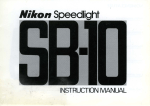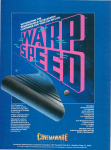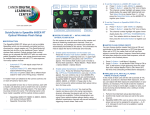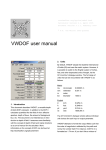Download QuickGuide to Canon 320EX Speedlite Features
Transcript
Key Features and Controls (back) Channel selection switch Assigns firing channel for wireless operation. Slave flash channel must match master flash channel. Firing group selection switch Assigns firing group when 320EX is combined with other wireless Speedlites TELE lamp Glows steadily when the flash coverage matches the lens coverage. Blinks when coverage is too narrow for lens coverage. QuickGuide to Canon 320EX Speedlite Features The purpose of this QuickGuide is to provide a concise review of how to operate the basic features and functions of the Canon 320EX Speedlite. Unless otherwise noted, the following instructions require your 320EX Speedlite to be mounted to your camera’s hot shoe. This will allow your camera to communicate with the 320EX and for you to make flash settings with the camera’s menu system. E-TTL II Auto Flash Set-up For cameras with built-in flash: 1. Press the camera Menu button. 2. Select the first Shooting Menu (first camera icon on the left). 3. Select [Flash control] or [External Speedlite control]. 4. Select [External flash func. setting]. Press Set. 5. Set [Flash mode] to [E-TTL II] This step is not necessary for cameras that have no built-in flash. It is also not necessary if you have not previously changed the default flash settings on your camera. Camera Exposure Mode Settings The 320EX will function in any of the camera exposure modes listed below. The maximum shutter speed at which your camera can synchronize with the flash exposure is represented by “1/x sec” (such as 1/200th second on EOS Rebel models). 1 Manual LED light button Press and hold until the LED light turns on. LED light switch Set to M to enable Manual activation of LED light. Set to Auto with EOS models having auto LED illumination function, such as Rebel T3 and T3i. Power switch On turns on power Slave is for wireless operation Off shuts off power. Key Features and Controls (front) Mode Shutter speed Aperture Full Auto, P, A-DEP Set automatically (1/x sec. – 1/60 sec.) Automatic Flash head TV Set manually (1/x sec. – 30 sec.) Automatic AV Set automatically (1/x sec. – 30 sec.) Manual M Set manually (1/x sec. – 30 sec., Bulb) Manual Remote release button Allows remote triggering of cameras compatible with the RC-1, RC-5, or RC-6 Remote Controllers* The mode you choose will depend mainly on the balance you prefer between the flash exposure and ambient light exposure. Longer shutter speeds will allow longer ambient light exposures to help prevent dark backgrounds; however, long exposures also risk blur from subject or camera motion. Smaller apertures provide more depthof-field but require more flash power and reduce the maximum flash range. Flash Coverage The flash head can be manually extended or retracted to better match the flash coverage to the camera and lens in use. Refer to the table below for recommended settings. Camera type Flash Head Normal Head Extended APS-C size sensor (Rebel series, 60D, 7D) 15mm or longer lens 32mm or longer lens Full-frame sensor (EOS 5D & 1Ds series) 24mm or longer lens 50mm or longer lens 2 LED light Wireless sensor Remote control transmitter * EOS Digital Rebel; Rebel XT, XTi; Rebel XSi; Rebel T1i, T2i, T3i; EOS 7D, EOS 5D Mark II (as of mid-2011). E-TTL II Flash Range The flash range will vary depending on the ISO setting, angle of coverage, and maximum aperture of your lens. If you see a blinking <> icon in your viewfinder then your subject is too far away. You should either move closer or increase the ISO. The table on the reverse side provides a guide to minimum and maximum shooting ranges for the EF-S 18-55mm f/3.5-5.6 IS zoom. Do not use the 320EX in the extended position at a focal length of 18mm or less, or the edges of the frame will be darker than the center. 3 ISO Head in Normal Position Head in Extended Position 18mm 55mm 18mm 55mm 100 1 – 6.9 m 3.3 – 22.6 ft 1 – 4.3 m 3.3 – 14.1 ft — 1 – 5.7 m 3.3 – 18.7 ft 200 1 – 9.7 m 3.3 – 31.8 ft 1 – 6.1 m 3.3 – 20 ft — 1 – 8.1 m 3.3 – 26.6 ft 400 1 – 13.7 m 3.3 – 44.9 ft 1 – 8.6 m 3.3 – 28.2 ft — 1 – 11.4 m 3.3 – 37.4 ft 800 1.2 – 19.4 m 3.9 – 63.6 ft 1 – 12.1 m 3.3 – 39.7 ft — 1 – 16.2 m 3.3 – 53.1 ft 1600 1.7 – 27.4 m 5.6 – 89.9 ft 1 – 17.1 m 3.3 – 56.1 ft — 1 – 22.9 m 3.3 – 75.1 ft LED Light The built-in LED light provides continuous illumination. This is particularly useful when shooting video, as a modeling light, or as an AF assist beam (with Live View). The LED light can provide up to 3.5 hours of illumination with four fully-charged AA batteries. It will automatically shut off after 60 minutes of idle use to conserve battery power. If battery power is low the LED Light will not turn on, even if the flash ready light is lit, in which case you should replace the batteries. Manual Flash Set-up You can manually adjust the flash output from full 1/1 to 1/64th power by using the External Flash Menu on compatible EOS SLRs*. The lower the flash output, the shorter the maximum range and the closer the minimum distance. The higher the flash output, the greater the maximum range. Use a hand-held flash meter or trial-anderror to determine the correct aperture for a given flash-tosubject distance. Once set, the exposure will remain the same as long as the distance and flash power level remain the same. 1. Press the camera Menu button*. 2. Select the first Shooting Menu (first camera icon on the left). 3. Select [Flash control] or [External Speedlite control]. 4. Select [External flash func. setting]. Press Set. 5. Scroll down to Manual flash. Press Set. 6. Select Flash output. Press Set. 7. Select the flash output you want. Press Set. Wireless E-TTL Flash Operation The “Slave” function allows the flash to be triggered wirelessly when used off-camera with an EOS DSLR or Speedlite with master flash function. The slave flash must be positioned off-camera and must be within a range of 33 feet (10 meters) from the master flash unit. The 320EX can be assigned to any one of four channels and three groups. The channel setting (1, 2, 3 or 4) must match the channel setting on the camera or master unit. The group setting (A, B or C) is important only if you are using more than one Speedlite, in which case you must assign them to the same group if you want equally distributed output or different groups if you want unequally distributed (ratio) output. 1. Set the camera, ST-E2 transmitter or 580EX II Speedlite as the master unit. 2. Set the 320EX as the slave unit by moving the power switch to <SLAVE>. 3. Set the transmission channel to the same channel as the master unit. 4. Set the firing group (if using more than one slave). 5. Attach the 320EX to the mini-stand (provided with the flash case) and position the flash. When outdoors you must have the wireless sensor aimed toward the master unit. When indoors the sensor will usually react to reflections from nearby walls. 6. Release the shutter. Wireless Shutter Release The flash release function uses the 320EX’s built-in infrared transmitter to trigger compatible cameras* with a 2-second delay. You can choose whether to use the 320EX as a wireless trigger only or whether to also use it as a wirelessly triggered slave flash. To trigger camera only: 1. Set the camera to Remote/Self-Timer mode. 2. Set the 320EX power switch to <ON> 3. Point the remote control transmitter on the front of the 320EX toward the camera, then press the remote release button. The shutter will release two seconds later. The 320EX will not fire. To trigger camera + wireless flash: 1. The camera must have a "master unit" triggering device for Wireless E-TTL flash mounted and active.. 2. Set the 320EX power switch to <SLAVE>. 4. Set the camera to Remote/Self-Timer mode. 3. Point the remote control transmitter toward the front of the camera, then press the remote release button. The camera will fire two seconds later, which allows time to reposition the 320EX to illuminate the subject. The master flash will trigger the 320EX you’re holding. Auto Power Off The 320EX will automatically shut off after 90 seconds of idle use to save battery power. Press the camera’s shutter button to turn the unit on again. When using the 320EX as a wireless slave you may wish to cancel the auto power off function by pressing the [✻] button on your camera. AF-Assist Beam To facilitate autofocus for dark scenes, the flash may fire repeatedly when you press the camera’s shutter button halfway. Its maximum AF-Assist range is approximately 2.3 - 13.1 ft., depending on the ISO setting and maximum aperture of your lens. * EOS Digital Rebel; Rebel XT, XTi; Rebel XSi; Rebel T1i, T2i, T3i; EOS 7D, EOS 5D Mark II (as of mid-2011). * Cameras with External Flash Menu: EOS 40D~60D, Rebel XS/ XSi, T1i, T2i, T3, T3i, EOS 7D, 5D Mark II, EOS-1D Mark III / Mark IV, EOS-1Ds Mark III 4 5 6











